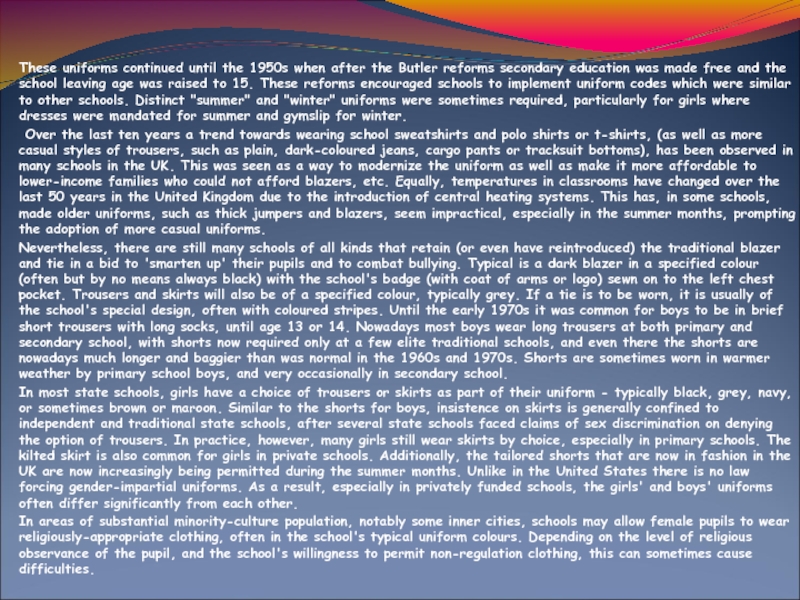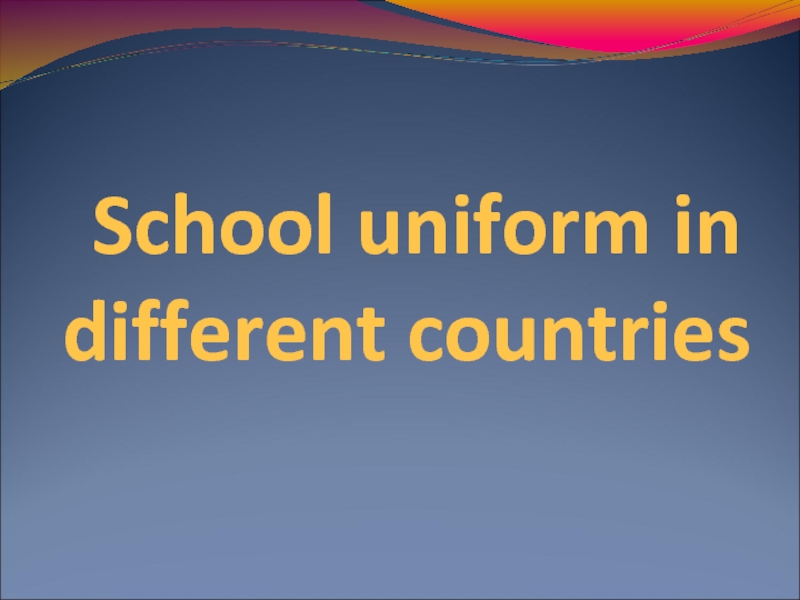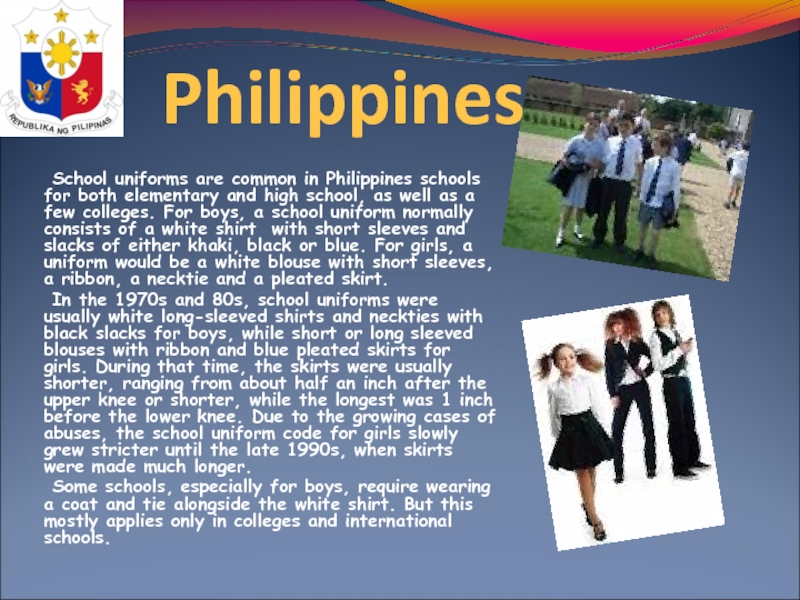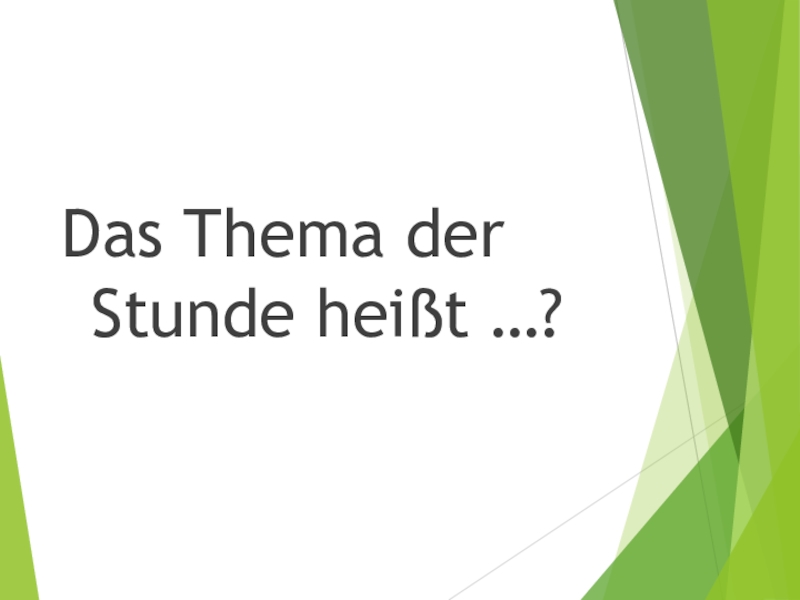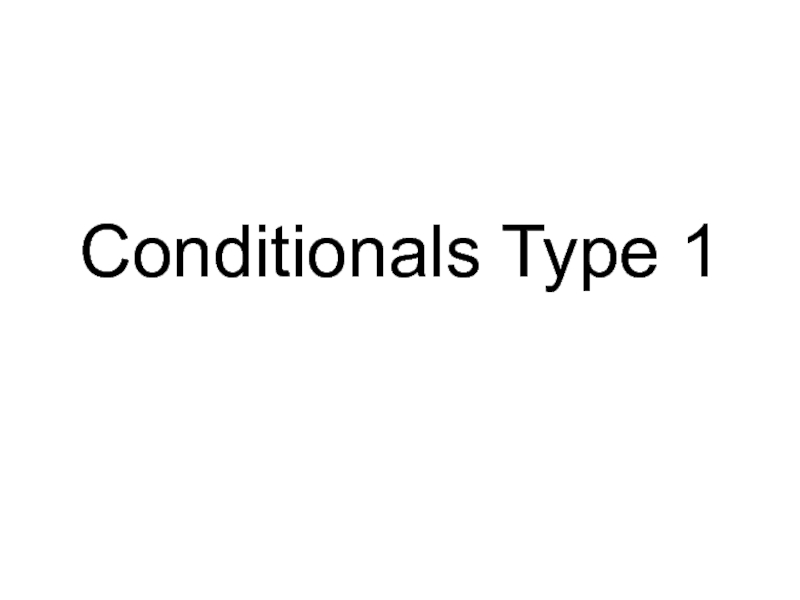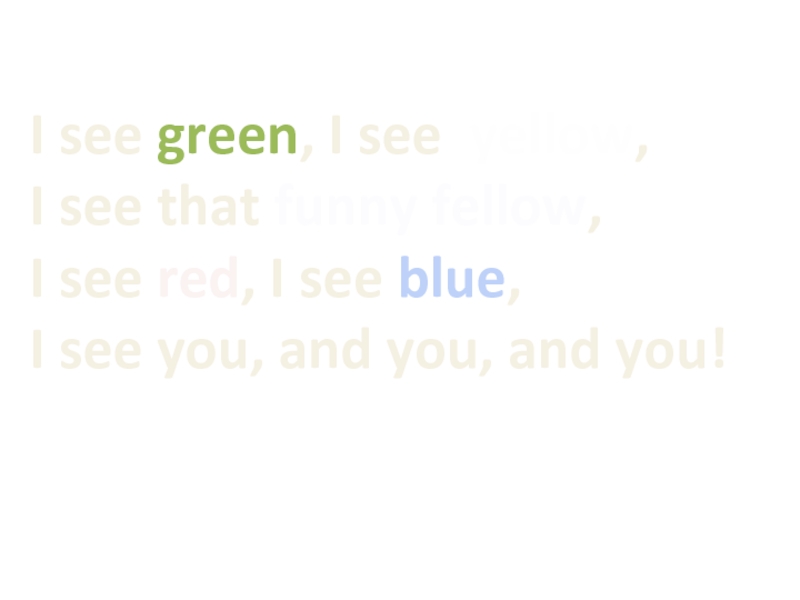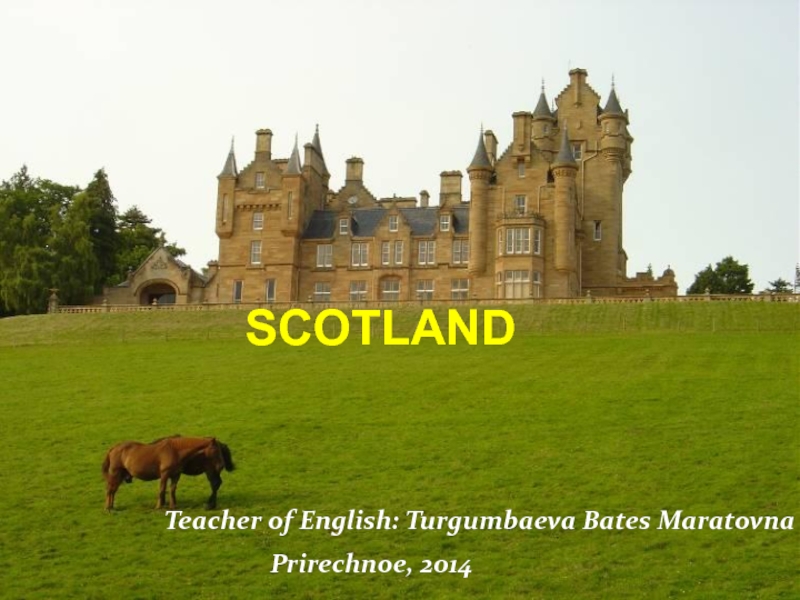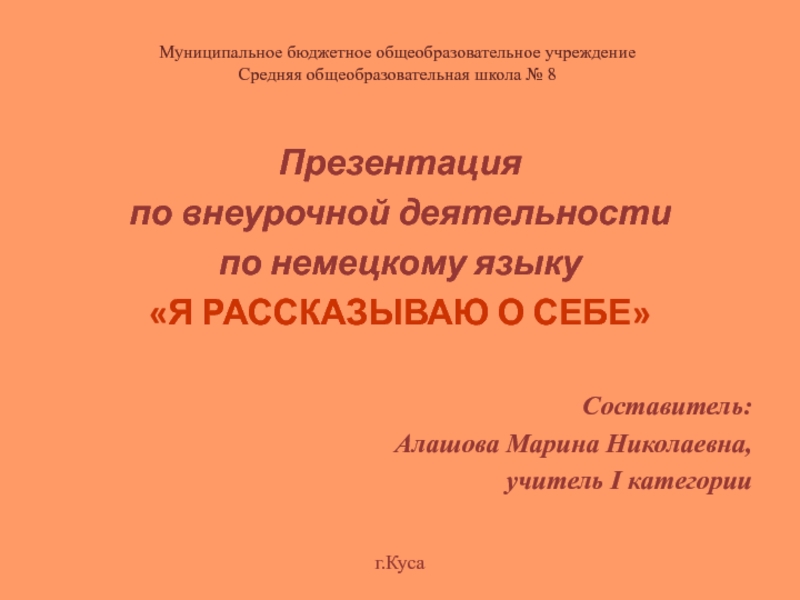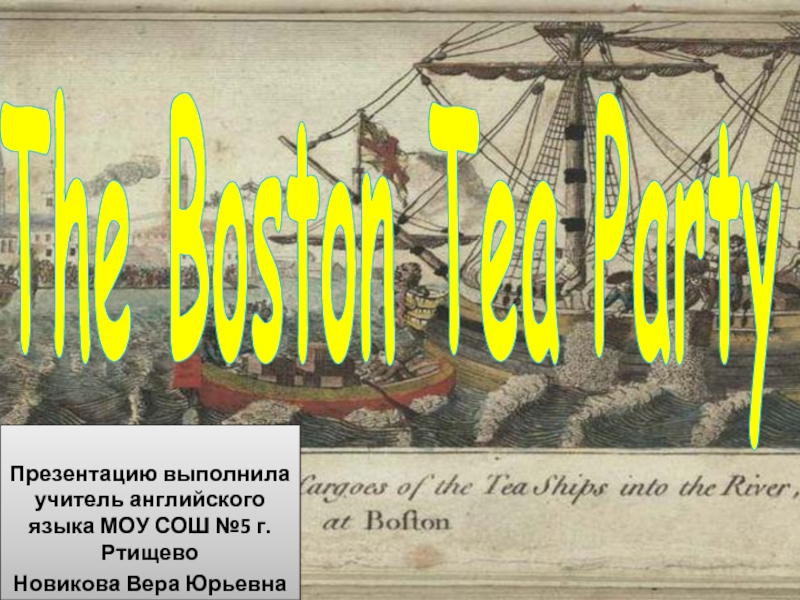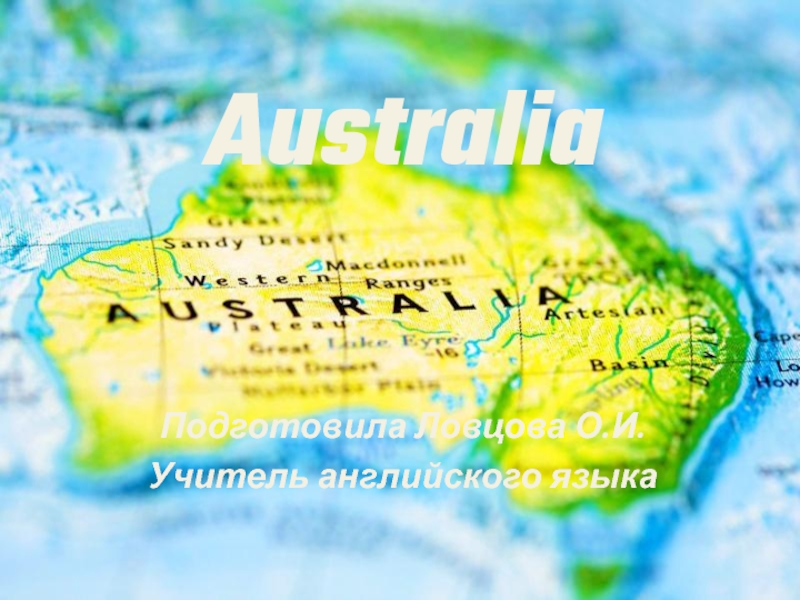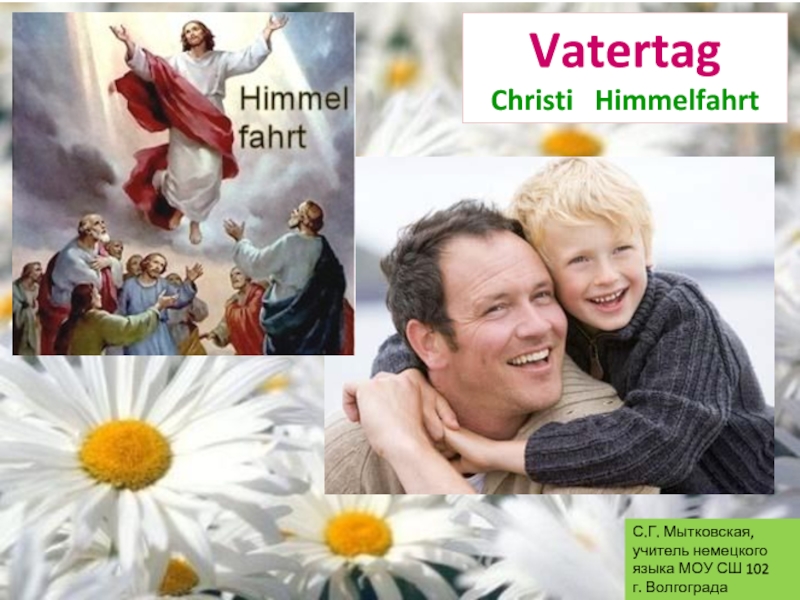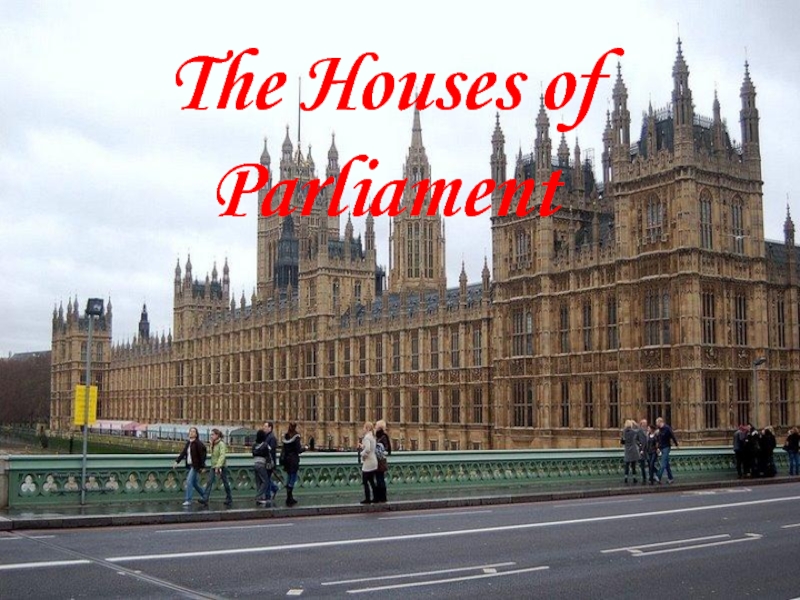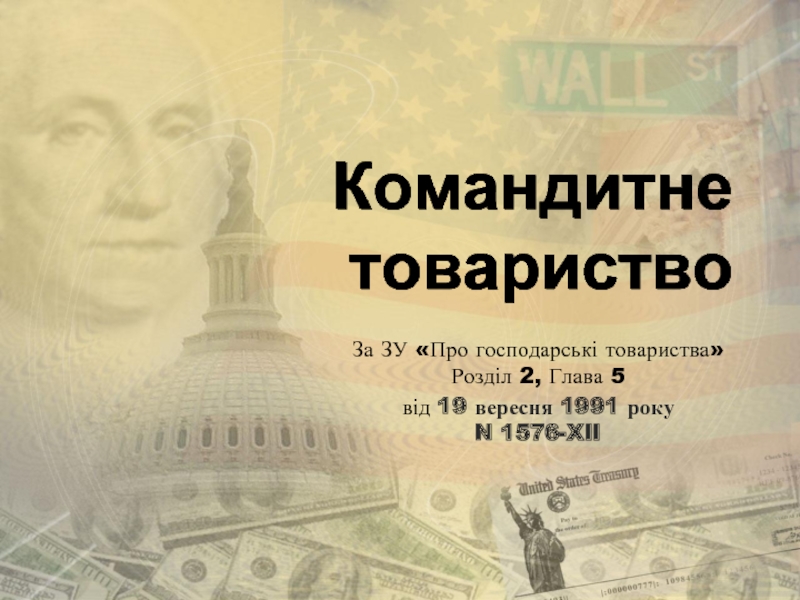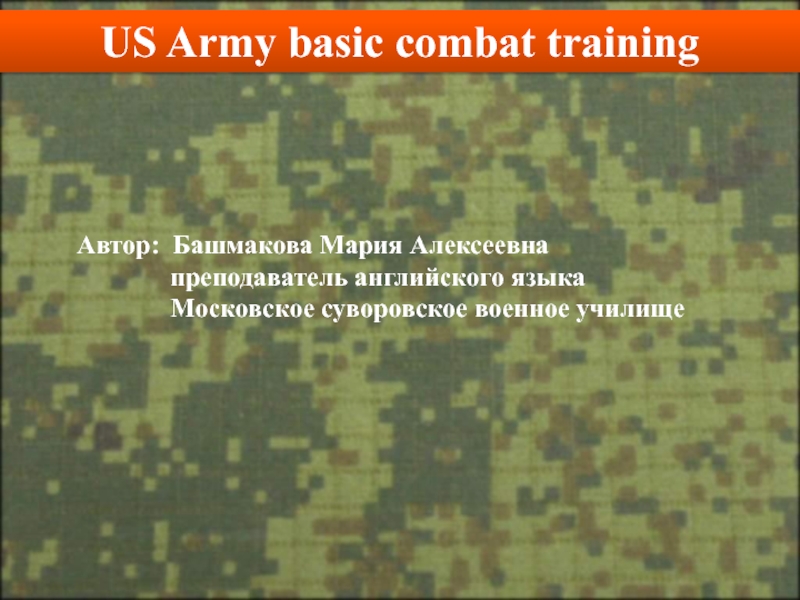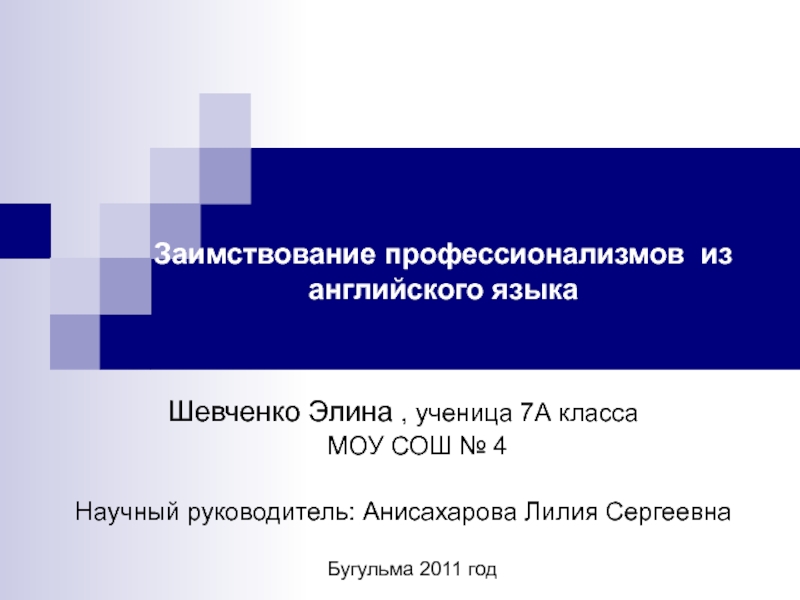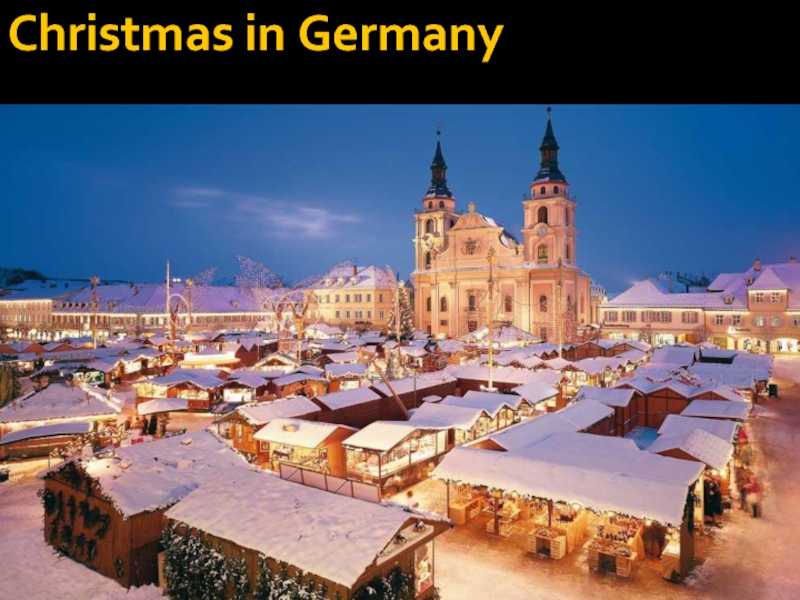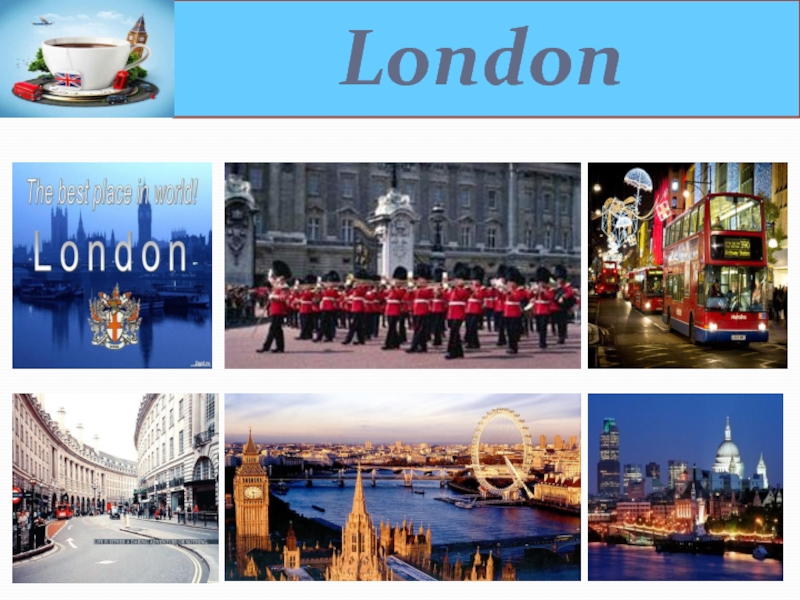Слайд 1 School uniform in different countries
Слайд 2Cambodia
Uniforms take a role in began the fashion for Cambodia
society today. Before, school uniform became free for students just
a white shirt, a blue or black skirt and trousers. In recent years, school uniform transferred into more strong and hard, suitable more for education. From Primary to Secondary school uniform allowed a male student and a female student in the way they wanted but follow the style that school allowed. However, in high school, the female student must worn the skirt not up their high but down their knees.
Uniforms are a common part of schools in China. Almost all secondary schools as well as some elementary schools require students to wear uniforms. Uniforms in mainland China usually consist of two sets, one for summer and other for winter. Uniforms for boys in winter usually consist of a zip up sweater and pants, and a collared shirt (usually white) with shorts or pants. The uniforms for girls in winter are basically the same as the boys' uniform. However, summer uniform for girls does not consist only of a coloured shirt and pants, they also have the option of a skirt.
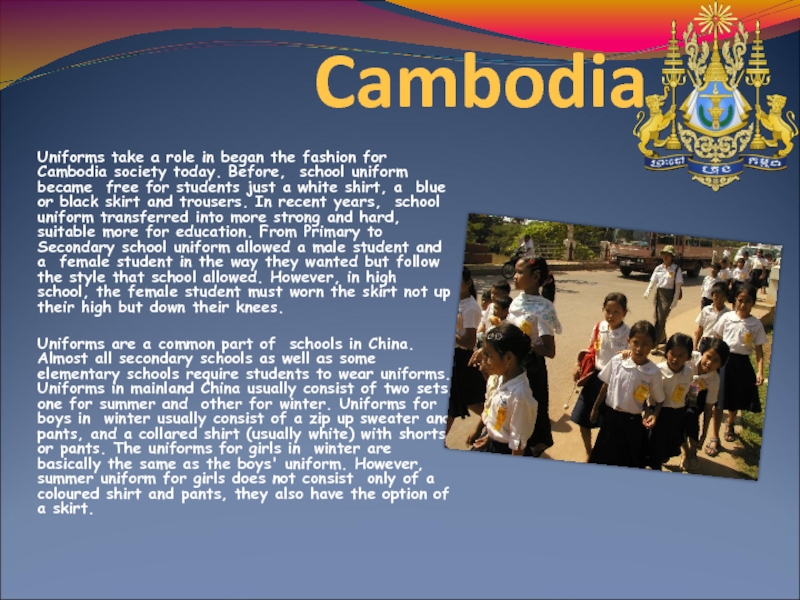
Слайд 3Germany
School uniforms have no strong tradition in
Germany and are
virtually unknown today.
From the 16th century, students (especially of secondary
or grammar schools and similar institutions) were often subject to regulations that prescribed, for example, modest and not too stylish attire. In many cases these regulations were part of wider laws concerning the clothing of all citizens of certain social classes. A blue coat became a widespread, obligatory status symbol of students of secondary schools; it fell out of use during the later half of the 18th century. In newer times, school uniforms in any real sense did not exist outside of convent schools and private boarding schools. At times, certain fashions became so widespread that they approached uniform status; this is true in particular for so-called student hats that became widespread from the 1880s on and remained somewhat popular until they were banned by the Nazis. Their wearing was advocated by teachers and students themselves and occasionally made mandatory, but never on a national or state-wide level. Another instance are the sailor suits that became fashionable around the turn of the 19th century. These were not usually a prescribed uniform.
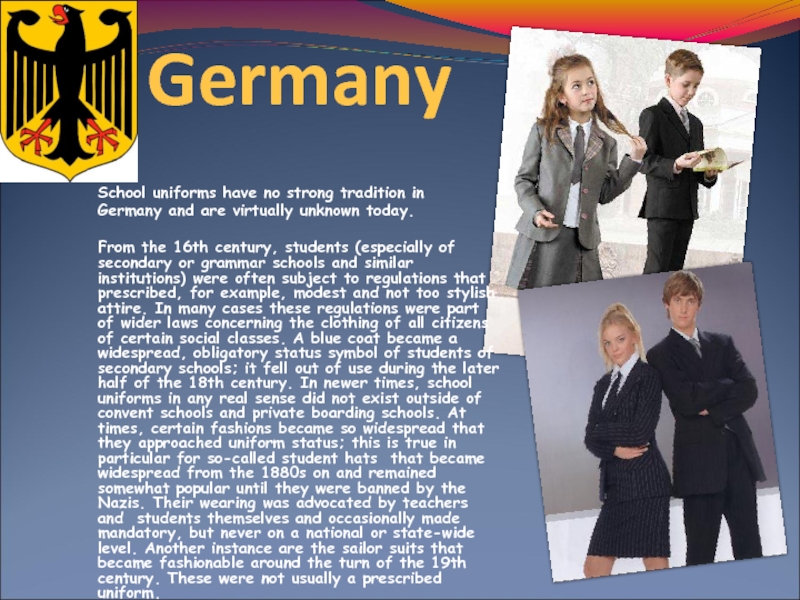
Слайд 4Israel
According to former Education Minister Limor Livnat, about 1,400 Israeli
public schools require pupils to wear uniforms.
School uniforms used to
be the norm in Israel in the state's early days, but have since fallen out of favour. However, in recent years, the number of schools using school uniforms have been increasing once more. Many teachers, parents and students are in favour of returning the school uniform to common use to prevent the deepening of the gap between affluent children and those less well-off. Nowadays school uniforms are mainly associated with schools belonging to the national religious school system, which is separated from secular Jewish schools. Arab Israeli schools also frequently require uniforms: for girls, it is often a pinafore to be worn over trousers and shirt.
Today, school uniforms in Israel consist only of a shirt with the school logo. In summer, the uniform shirt is a simple T-shirt, while in winter, the shirts worn are warm or hooded sweaters. Although the shirts are uniform, they usually come in various colours, and allow students to customize and express themselves even while wearing a uniform. The shirts sell for a very small amount of money, so that even those who do not have a lot of money can acquire them.

Слайд 5Italy
In Italy, school uniforms are uncommon, partially because child uniforms
are associated with the era of Benito Mussolini before World
War II when children were placed according to their age into Italian Fascist youth movements and had to wear uniforms inside and outside school.
However, until the early 1970s many high schools required girls to wear black grembiule (resembling a doctor smock) on top of their clothes: no uniform was required for boys. Perhaps this was because at one time high schools were the only public schools to be co-ed (as opposed to junior schools and elementary), and girls may be required to "cover up" not to distract their male counterparts. Indeed this policy was highly disputed in the 1960s and later abolished.
Nowadays, many pre-schools advise parents to dress their children with a grembiulino, i.e., a small grembiule, usually shorter and more colorful, that can be purchased cheaply.
Some elementary schools advise some kind of grembiule for the younger pupils. Sometimes girls are required to wear a pink or white grembiulino, while boys may be required to wear a short cotton jacket, usually blue or black. In other cases both boys and girls may be required to wear a more neutral blue grembiule.
Some parents send their children to school in a grembiule even if the school does not require it.
Poet and children's writer Gianni Rodari has described adult life as "a school without grembiule and school desk".
In 2004 the Italian chapter of WWF warned that synthetic grembiules were harmful to pupils.
In July 2008 Education Minister Mariastella Gelmini proposed the re-introduction of the compulsory smock in public schools, provoking a debate in the Italian press.
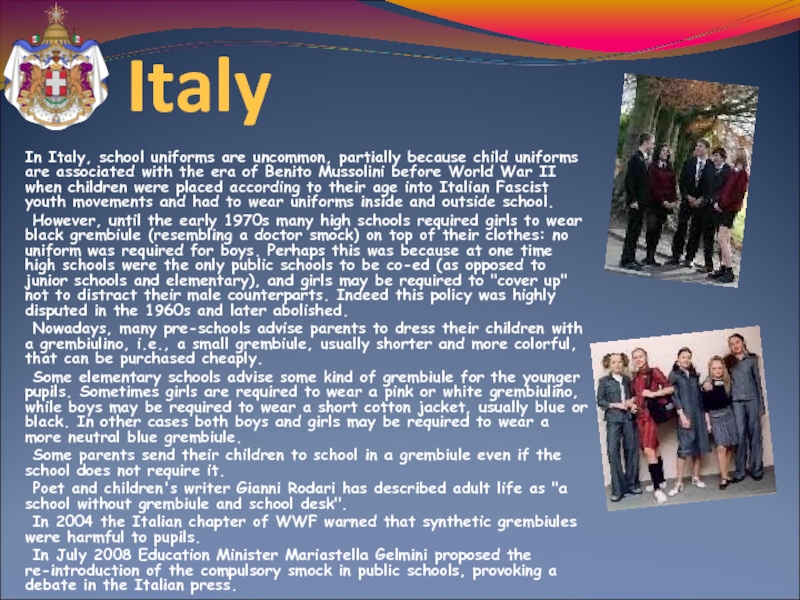
Слайд 6New Zealand
Traditionally, many New Zealand Intermediate and high schools have
followed the British system of school uniforms, although it is
common in state schools for the boy's uniform to have a jersey and grey short trousers rather than a blazer with tie and pants (long trousers). This usually consists of a variety of the following apparel: an 'official' school jersey, jacket and tie, a grey/white shirt, pants and/or shorts, and, in many girls' schools, kilts. Blazers and jackets are of varied colours according to the school - dark or light blue, grey, crimson, scarlet, green or black. Some follow the British practice of having contrasting colours edging the lapels and jacket fronts. Caps or other headwear have generally been discarded since the 1970s. Where short trousers are worn, boys are usually required to wear long dark socks, which may require garters to hold them up.
Being allowed to wear long trousers as part of the uniform, rather than shorts, often marks the transition from junior to senior classes. At some schools, seniors are allowed to wear casual clothing, known colloquially as "mufti“.
During the 1980s and 1990s there was a tendency for the traditional uniform to be replaced by cheaper and more 'modern' options: polo shirts, polar fleece tops, or a complete doing away with uniforms in favour of mufti. This trend seems to have been reversed in recent years and only a small number of secondary schools now do not have uniforms at all. Intermediate schools usually provide the option of skirts or culottes for girls and sometimes shorts while boys will wear shorts. Also bike shorts or tights are sometimes worn under girls' skirts. At high school girls will usually wear culottes, skirts or pants and boys will wear shorts or pants. Some girls' schools also have navy blue skirts and open necked white blouses long in winter and short in summer, as the skirts are not allowed higher than below the knee; the skirts also have splits up the center at the back.
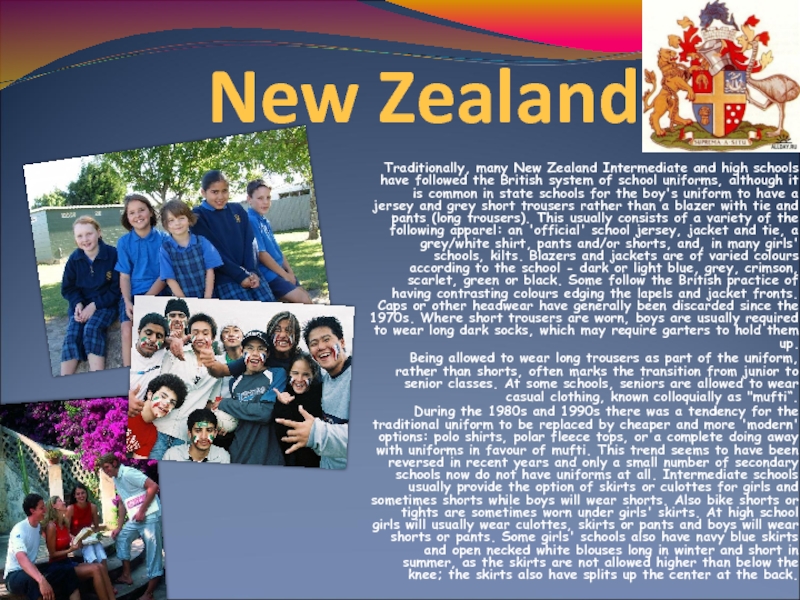
Слайд 7Philippines
School uniforms are common in Philippines schools for both elementary
and high school, as well as a few colleges. For
boys, a school uniform normally consists of a white shirt with short sleeves and slacks of either khaki, black or blue. For girls, a uniform would be a white blouse with short sleeves, a ribbon, a necktie and a pleated skirt.
In the 1970s and 80s, school uniforms were usually white long-sleeved shirts and neckties with black slacks for boys, while short or long sleeved blouses with ribbon and blue pleated skirts for girls. During that time, the skirts were usually shorter, ranging from about half an inch after the upper knee or shorter, while the longest was 1 inch before the lower knee. Due to the growing cases of abuses, the school uniform code for girls slowly grew stricter until the late 1990s, when skirts were made much longer.
Some schools, especially for boys, require wearing a coat and tie alongside the white shirt. But this mostly applies only in colleges and international schools.
Слайд 8Russia
.
In Russia, school uniforms were abolished after the 1917 revolution,
but were re-introduced in 1948. Initially, the new uniform was
very similar to that in place before the communist takeover. Wearing uniform was made mandatory and pupils were penalized for not following the rules.
The style of Soviet school uniform was modernized in 1962, and since that time was modified each decade. There could be some variations across different Soviet Republics. Boys generally wore dark blue pants and jackets, girls — brown dresses with black aprons and black bows (on special occasions, white aprons and bows were worn). The members of the Young Pioneer organization, to which literally every student belonged, wore famous red neckties. Special sport uniforms also existed for physical education classes. In the early 1980s, a dark blue three-piece suit was introduced for girls and the strict rules on haircuts were loosened.
In 1992, mandatory school uniforms were abolished. Today, there is no unified standard uniform in Russia; however, certain schools may have their own uniform that students are required to wear. Educational institutions without a uniform may also have a certain dress code.
There is also a modern-day tradition for girls to dress into brown Soviet-style school uniform for their graduation ceremony.
Girls at the last bell celebration, wearing the traditional Soviet school uniform
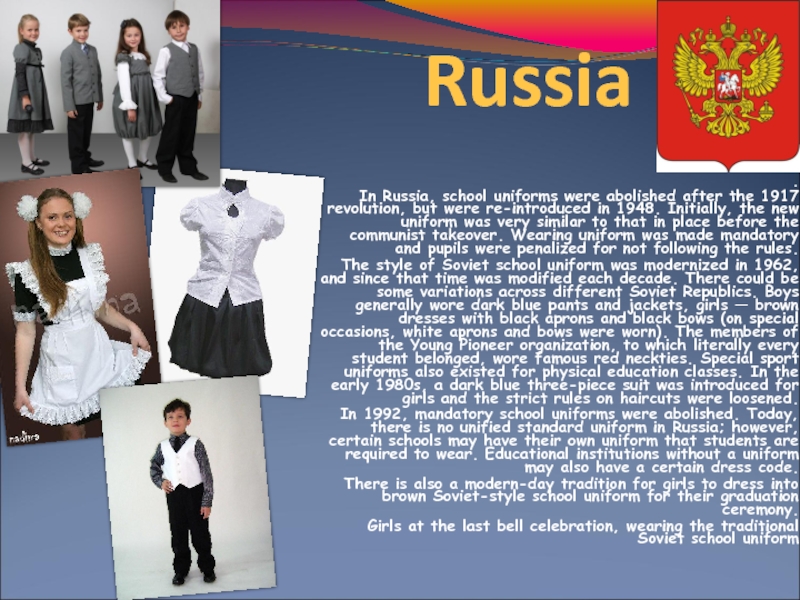
Слайд 9United Kingdom
Many British primary and secondary schools require pupils to
wear uniforms, but further education colleges and some school sixth-forms
(for age 16+) do not usually have a uniform.
Schools vary widely as to how prescriptive the uniform is, and how much the wearing of it is enforced.
School uniforms are required to be fair for both genders, provide a reasonably low cost and tolerate religious freedoms e.g. allowing Sikhs to wear turbans.
School uniforms were first introduced on a large scale during the reign of King Henry VIII. The uniforms of the time were referred as "bluecoats", as they consisted of long trench-coat-style jackets dyed blue. Blue was the cheapest available dye and showed humility amongst all children. The first school to introduce this uniform was Christ's Hospital and it is the oldest uniform of any school.
In 1870 the Elementary Education act introduced free primary education for all children. The popularity of uniforms increased and eventually most schools had a uniform. During this period most uniforms reflected the trends of the age, with boys wearing short trousers and blazers until roughly the age of puberty and then long trousers from about 14 or 15. Girls mainly wore blouse, tunic dress and pinafore later progressing towards the beginning of the 20th century to gymslips.
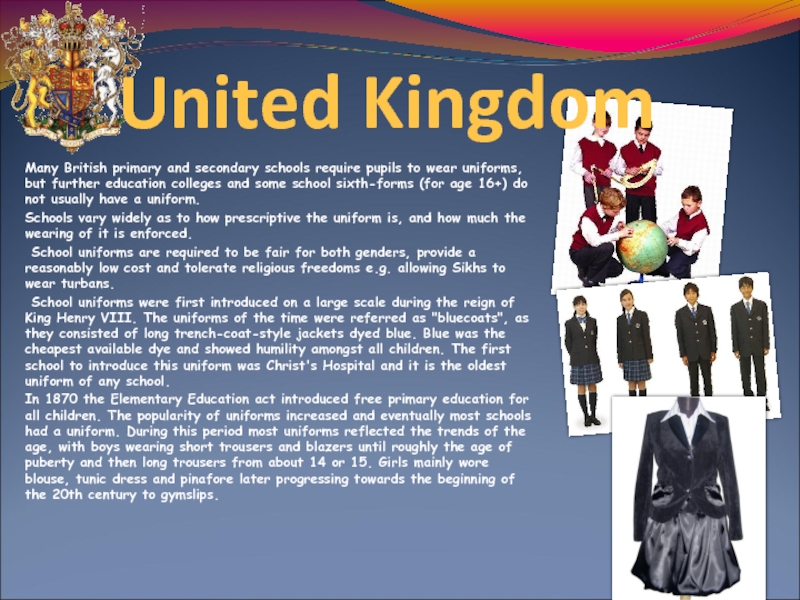
Слайд 10These uniforms continued until the 1950s when after the Butler
reforms secondary education was made free and the school leaving
age was raised to 15. These reforms encouraged schools to implement uniform codes which were similar to other schools. Distinct "summer" and "winter" uniforms were sometimes required, particularly for girls where dresses were mandated for summer and gymslip for winter.
Over the last ten years a trend towards wearing school sweatshirts and polo shirts or t-shirts, (as well as more casual styles of trousers, such as plain, dark-coloured jeans, cargo pants or tracksuit bottoms), has been observed in many schools in the UK. This was seen as a way to modernize the uniform as well as make it more affordable to lower-income families who could not afford blazers, etc. Equally, temperatures in classrooms have changed over the last 50 years in the United Kingdom due to the introduction of central heating systems. This has, in some schools, made older uniforms, such as thick jumpers and blazers, seem impractical, especially in the summer months, prompting the adoption of more casual uniforms.
Nevertheless, there are still many schools of all kinds that retain (or even have reintroduced) the traditional blazer and tie in a bid to 'smarten up' their pupils and to combat bullying. Typical is a dark blazer in a specified colour (often but by no means always black) with the school's badge (with coat of arms or logo) sewn on to the left chest pocket. Trousers and skirts will also be of a specified colour, typically grey. If a tie is to be worn, it is usually of the school's special design, often with coloured stripes. Until the early 1970s it was common for boys to be in brief short trousers with long socks, until age 13 or 14. Nowadays most boys wear long trousers at both primary and secondary school, with shorts now required only at a few elite traditional schools, and even there the shorts are nowadays much longer and baggier than was normal in the 1960s and 1970s. Shorts are sometimes worn in warmer weather by primary school boys, and very occasionally in secondary school.
In most state schools, girls have a choice of trousers or skirts as part of their uniform - typically black, grey, navy, or sometimes brown or maroon. Similar to the shorts for boys, insistence on skirts is generally confined to independent and traditional state schools, after several state schools faced claims of sex discrimination on denying the option of trousers. In practice, however, many girls still wear skirts by choice, especially in primary schools. The kilted skirt is also common for girls in private schools. Additionally, the tailored shorts that are now in fashion in the UK are now increasingly being permitted during the summer months. Unlike in the United States there is no law forcing gender-impartial uniforms. As a result, especially in privately funded schools, the girls' and boys' uniforms often differ significantly from each other.
In areas of substantial minority-culture population, notably some inner cities, schools may allow female pupils to wear religiously-appropriate clothing, often in the school's typical uniform colours. Depending on the level of religious observance of the pupil, and the school's willingness to permit non-regulation clothing, this can sometimes cause difficulties.
